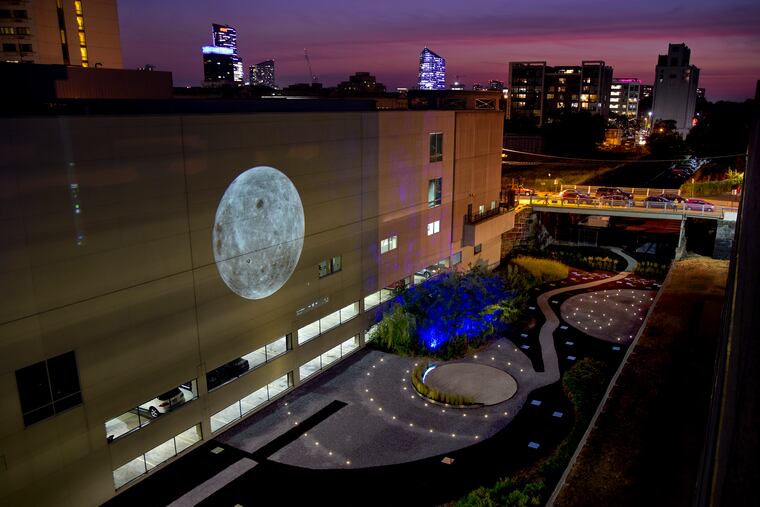Explore the Rail Park of Philadelphia’s future at this free two-week arts festival
In its current incarnation, the Rail Park has only realized a quarter-mile of the planned 3-mile expanse, which weaves through the Poplar and Spring Garden neighborhoods.

Imagine a mural. The picture that probably comes to mind is a monumental painting covering the wall of a building. Imagine a composition, and you’ll likely think of notes on paper guiding an orchestra or a string quartet. Imagine a park, and more often than not you end up with a bucolic expanse of greenery, benches, and trees.
A trio of Philly’s cultural organizations are joining forces this month to reimagine all three of those concepts through a 21st-century lens. Site/Sound: Revealing the Rail Park is a two-week festival anchored by three large-scale art installations. Featuring both visual and sonic components, the pieces will be placed along portions of the historic Reading Railroad corridor that will eventually be incorporated into the Rail Park (which, in its current incarnation, has realized only a quarter-mile of the planned 3-mile park).
Organized by the Friends of the Rail Park, Mural Arts Philadelphia, and the American Composers Forum, the free festival will muse on the future of these now-abandoned sites while it revisits the city’s industrial past.
As Kevin Dow, executive director of the Friends of the Rail Park, explained, “In the past, the railroad connected things: coal with companies, then people with places, and people with other people. We want to make sure that we connect that historical past, the purpose of the railroads, with the intent that we have to use the Rail Park as a connector today.”
“Aspect 281,” created by artists Carolyn Healy and John JH Phillips, is inspired by the signaling technology that guided the railroad engineers and its echoes in today’s digital information technology. Three 9-foot sculptures evoking smokestacks will puff steam near the east parking lot at 990 Spring Garden St. A quadraphonic sound collage, made up primarily of railroad sounds, will accompany a three-story-high graphic depicting railroad signals and video projections with historic train footage.
In “Soon/Now/Gone,” Erik Ruin and Rosie Langabeer have built a series of zoopraxiscopes, 19th-century devices that predate the cinema, to go in the tunnels and underpasses of the Viaduct section of the park. The pieces flash back to the Victorian era, when the photographs and inventions of moving-picture pioneer Eadweard Muybridge (who spent a portion of his research career at the University of Pennsylvania) helped lay the groundwork for the film industry. Moving between three different locations — from Spring Garden Street to Shamokin Street to the Carlton Street Tunnel — over the two-week span, Ruin’s hand-drawn images will be projected via spinning glass disks that create the illusion of motion; the eclectic Langabeer provides a soundtrack of music and effects that’s triggered by visitors.
Nadia Hironaka, Matthew Suib, and Eugene Lew have crafted the “Moon Viewing Platform” near the Callowhill Cut, just north of Callowhill on 18th Street. The platform, inspired by Japanese rock gardens, offers a serene zen escape from the surrounding city. Musical performances and community gatherings, all celebrating compassion and communion, will take place in a platform in the center of the landscape garden, overlooked by building-sized video projections of short films.
The installations will be open to the public throughout the festival, and on Saturday nights, each site will feature live performances by equally inventive artists. This weekend’s performers include former Philadelphian Joshua Abrams and an expanded version of his mesmerizing ensemble Natural Information Society providing the soundtrack for sunset on the Moon Viewing Platform; a premiere of new pieces by cellist and oud player Kinan Abou-afach at the “Aspect 281” site; and a storytelling and magic lantern show at the Viaduct by Mary McCool and Carolyn Gennari.
“I feel like we could be entering a very interesting period for the range of things that actually constitute public art,” said Gene Coleman, director of the Philadelphia chapter of the American Composers Forum. “I hope that it moves far away from this idea of statues and monuments and big static objects. That history is not going away, but in my mind there’s no strong argument for saying we should continue to spend millions of dollars on huge lumps of metal. [This festival offers] an interesting set of propositions for what can be done now.”
That notion is crucial to Mural Arts as the organization contemplates its role in the future of the city. “Our practice has evolved over the last 10 years,” said founder and executive director Jane Golden. “We ... realized that our work is about community-based public art: tapping into the talent and richness of artists in our area and putting that to work on behalf of citizens.”
For all three organizations, Site/Sound offers an opportunity to introduce locals to new possibilities. For Mural Arts, it’s the idea of public art being conceptual and impermanent; for the ACF, it’s a chance to capture accidental audiences who might never purposely enter a concert hall for such alien sounds; and for the Rail Park, it helps visitors envision the sprawling future park they hope to bring to fruition.
“We sometimes like to say that we’re more vision than reality,” Dow said. “The Rail Park is not just a place, but it’s a space that engages the communities that surround us, where people can be connected with themselves or with other people.”
If you go: Besides live performances and art installations, Site/Sound: Revealing the Rail Park includes walking tours, workshops, and performances. See a full list of events, including a talk on the history of railroad signaling and an aboveground and belowground walking tour, at sitesoundphl.org. Oct. 5-19, various times and locations, free, sitesoundphl.org.